Case Study: Bioscience of Undergraduate Nursing - Wound Infection
VerifiedAdded on 2021/04/21
|8
|2480
|111
Case Study
AI Summary
This case study analyzes a wound infection in a 21-year-old patient who sustained a jagged laceration on her foot after stepping on broken glass. The assignment delves into the physiological basis of the wound observations, identifying redness, warmth, and purulent discharge as indicators of inflammation and infection. It explores both endogenous (purulent discharge) and exogenous (airborne microbes, contaminated handkerchief) sources of contamination and their modes of transmission. The case study provides rationales for the choice of antibiotics, including ceftriaxone, cephalexin, and dicloxacillin, considering their mechanisms of action and effectiveness against Staphylococcus aureus. It also addresses the adverse reactions of dicloxacillin, such as nausea, vomiting, and cholestatic jaundice. Finally, the assignment outlines the wound healing process, emphasizing the importance of cleaning, debridement, antibiotic ointment application, and proper bandaging to prevent further infection and promote healing, which is expected to take approximately two to three months.
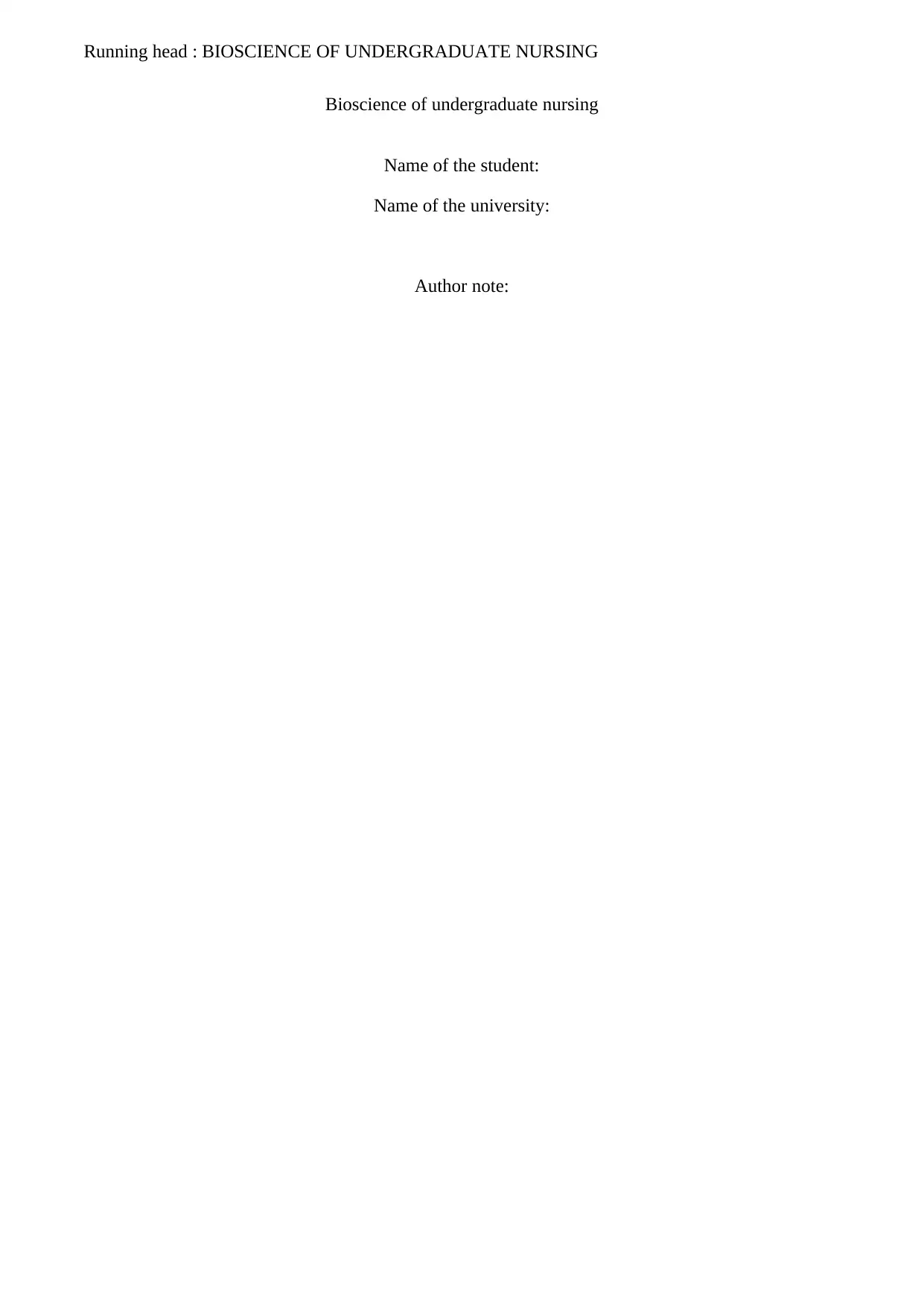
Running head : BIOSCIENCE OF UNDERGRADUATE NURSING
Bioscience of undergraduate nursing
Name of the student:
Name of the university:
Author note:
Bioscience of undergraduate nursing
Name of the student:
Name of the university:
Author note:
Paraphrase This Document
Need a fresh take? Get an instant paraphrase of this document with our AI Paraphraser
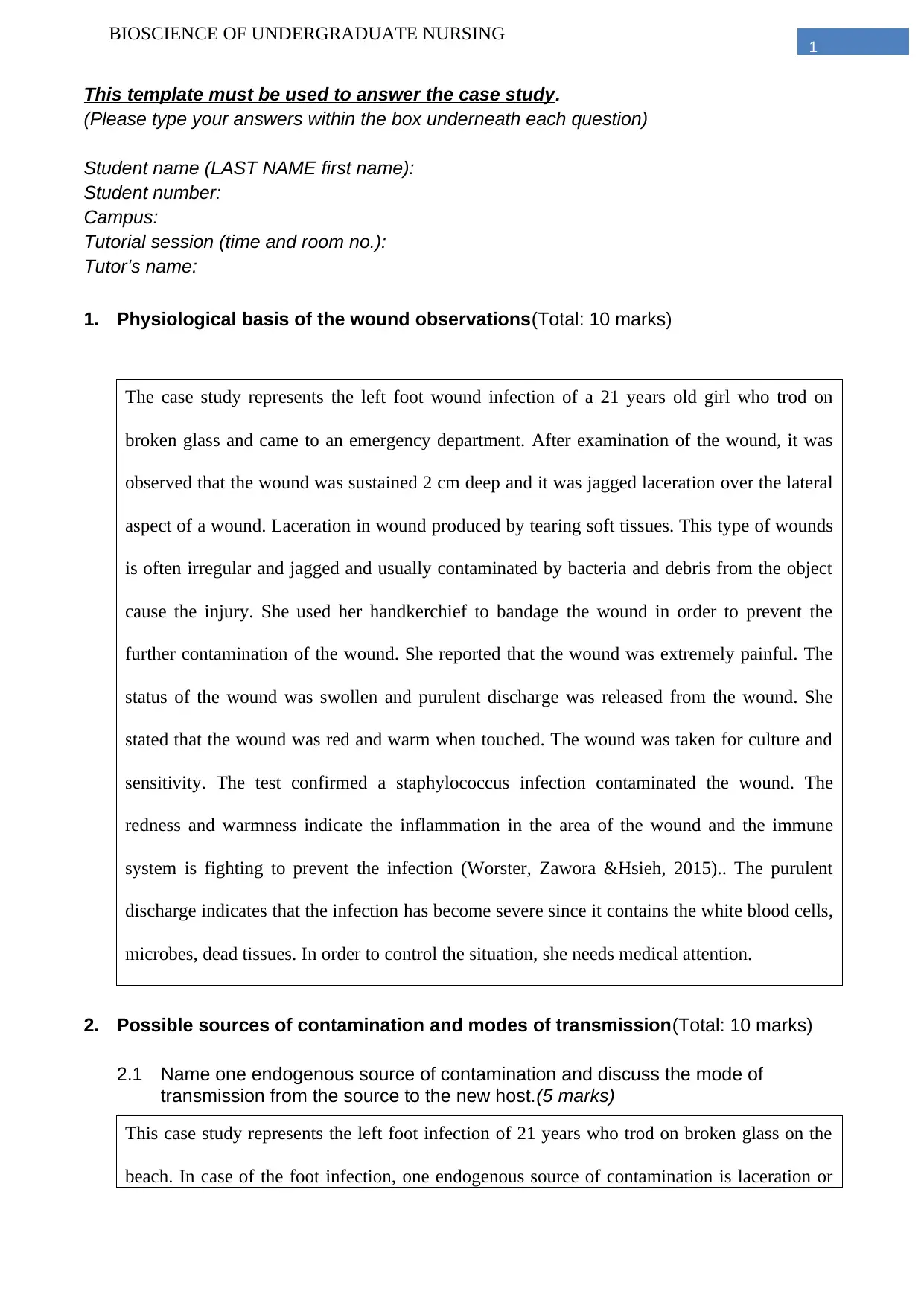
1
BIOSCIENCE OF UNDERGRADUATE NURSING
This template must be used to answer the case study.
(Please type your answers within the box underneath each question)
Student name (LAST NAME first name):
Student number:
Campus:
Tutorial session (time and room no.):
Tutor’s name:
1. Physiological basis of the wound observations(Total: 10 marks)
The case study represents the left foot wound infection of a 21 years old girl who trod on
broken glass and came to an emergency department. After examination of the wound, it was
observed that the wound was sustained 2 cm deep and it was jagged laceration over the lateral
aspect of a wound. Laceration in wound produced by tearing soft tissues. This type of wounds
is often irregular and jagged and usually contaminated by bacteria and debris from the object
cause the injury. She used her handkerchief to bandage the wound in order to prevent the
further contamination of the wound. She reported that the wound was extremely painful. The
status of the wound was swollen and purulent discharge was released from the wound. She
stated that the wound was red and warm when touched. The wound was taken for culture and
sensitivity. The test confirmed a staphylococcus infection contaminated the wound. The
redness and warmness indicate the inflammation in the area of the wound and the immune
system is fighting to prevent the infection (Worster, Zawora &Hsieh, 2015).. The purulent
discharge indicates that the infection has become severe since it contains the white blood cells,
microbes, dead tissues. In order to control the situation, she needs medical attention.
2. Possible sources of contamination and modes of transmission(Total: 10 marks)
2.1 Name one endogenous source of contamination and discuss the mode of
transmission from the source to the new host.(5 marks)
This case study represents the left foot infection of 21 years who trod on broken glass on the
beach. In case of the foot infection, one endogenous source of contamination is laceration or
BIOSCIENCE OF UNDERGRADUATE NURSING
This template must be used to answer the case study.
(Please type your answers within the box underneath each question)
Student name (LAST NAME first name):
Student number:
Campus:
Tutorial session (time and room no.):
Tutor’s name:
1. Physiological basis of the wound observations(Total: 10 marks)
The case study represents the left foot wound infection of a 21 years old girl who trod on
broken glass and came to an emergency department. After examination of the wound, it was
observed that the wound was sustained 2 cm deep and it was jagged laceration over the lateral
aspect of a wound. Laceration in wound produced by tearing soft tissues. This type of wounds
is often irregular and jagged and usually contaminated by bacteria and debris from the object
cause the injury. She used her handkerchief to bandage the wound in order to prevent the
further contamination of the wound. She reported that the wound was extremely painful. The
status of the wound was swollen and purulent discharge was released from the wound. She
stated that the wound was red and warm when touched. The wound was taken for culture and
sensitivity. The test confirmed a staphylococcus infection contaminated the wound. The
redness and warmness indicate the inflammation in the area of the wound and the immune
system is fighting to prevent the infection (Worster, Zawora &Hsieh, 2015).. The purulent
discharge indicates that the infection has become severe since it contains the white blood cells,
microbes, dead tissues. In order to control the situation, she needs medical attention.
2. Possible sources of contamination and modes of transmission(Total: 10 marks)
2.1 Name one endogenous source of contamination and discuss the mode of
transmission from the source to the new host.(5 marks)
This case study represents the left foot infection of 21 years who trod on broken glass on the
beach. In case of the foot infection, one endogenous source of contamination is laceration or
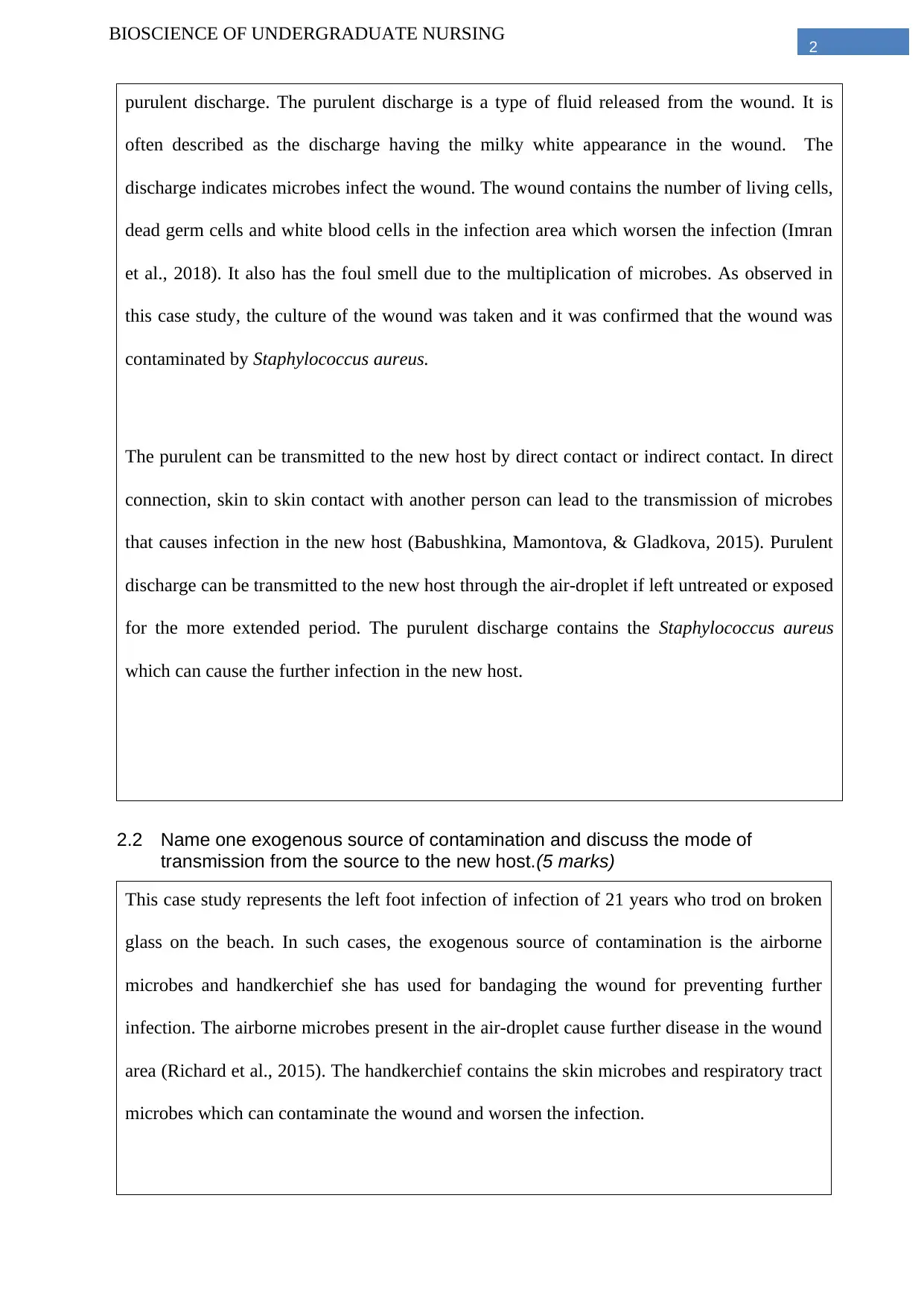
2
BIOSCIENCE OF UNDERGRADUATE NURSING
purulent discharge. The purulent discharge is a type of fluid released from the wound. It is
often described as the discharge having the milky white appearance in the wound. The
discharge indicates microbes infect the wound. The wound contains the number of living cells,
dead germ cells and white blood cells in the infection area which worsen the infection (Imran
et al., 2018). It also has the foul smell due to the multiplication of microbes. As observed in
this case study, the culture of the wound was taken and it was confirmed that the wound was
contaminated by Staphylococcus aureus.
The purulent can be transmitted to the new host by direct contact or indirect contact. In direct
connection, skin to skin contact with another person can lead to the transmission of microbes
that causes infection in the new host (Babushkina, Mamontova, & Gladkova, 2015). Purulent
discharge can be transmitted to the new host through the air-droplet if left untreated or exposed
for the more extended period. The purulent discharge contains the Staphylococcus aureus
which can cause the further infection in the new host.
2.2 Name one exogenous source of contamination and discuss the mode of
transmission from the source to the new host.(5 marks)
This case study represents the left foot infection of infection of 21 years who trod on broken
glass on the beach. In such cases, the exogenous source of contamination is the airborne
microbes and handkerchief she has used for bandaging the wound for preventing further
infection. The airborne microbes present in the air-droplet cause further disease in the wound
area (Richard et al., 2015). The handkerchief contains the skin microbes and respiratory tract
microbes which can contaminate the wound and worsen the infection.
BIOSCIENCE OF UNDERGRADUATE NURSING
purulent discharge. The purulent discharge is a type of fluid released from the wound. It is
often described as the discharge having the milky white appearance in the wound. The
discharge indicates microbes infect the wound. The wound contains the number of living cells,
dead germ cells and white blood cells in the infection area which worsen the infection (Imran
et al., 2018). It also has the foul smell due to the multiplication of microbes. As observed in
this case study, the culture of the wound was taken and it was confirmed that the wound was
contaminated by Staphylococcus aureus.
The purulent can be transmitted to the new host by direct contact or indirect contact. In direct
connection, skin to skin contact with another person can lead to the transmission of microbes
that causes infection in the new host (Babushkina, Mamontova, & Gladkova, 2015). Purulent
discharge can be transmitted to the new host through the air-droplet if left untreated or exposed
for the more extended period. The purulent discharge contains the Staphylococcus aureus
which can cause the further infection in the new host.
2.2 Name one exogenous source of contamination and discuss the mode of
transmission from the source to the new host.(5 marks)
This case study represents the left foot infection of infection of 21 years who trod on broken
glass on the beach. In such cases, the exogenous source of contamination is the airborne
microbes and handkerchief she has used for bandaging the wound for preventing further
infection. The airborne microbes present in the air-droplet cause further disease in the wound
area (Richard et al., 2015). The handkerchief contains the skin microbes and respiratory tract
microbes which can contaminate the wound and worsen the infection.
⊘ This is a preview!⊘
Do you want full access?
Subscribe today to unlock all pages.

Trusted by 1+ million students worldwide
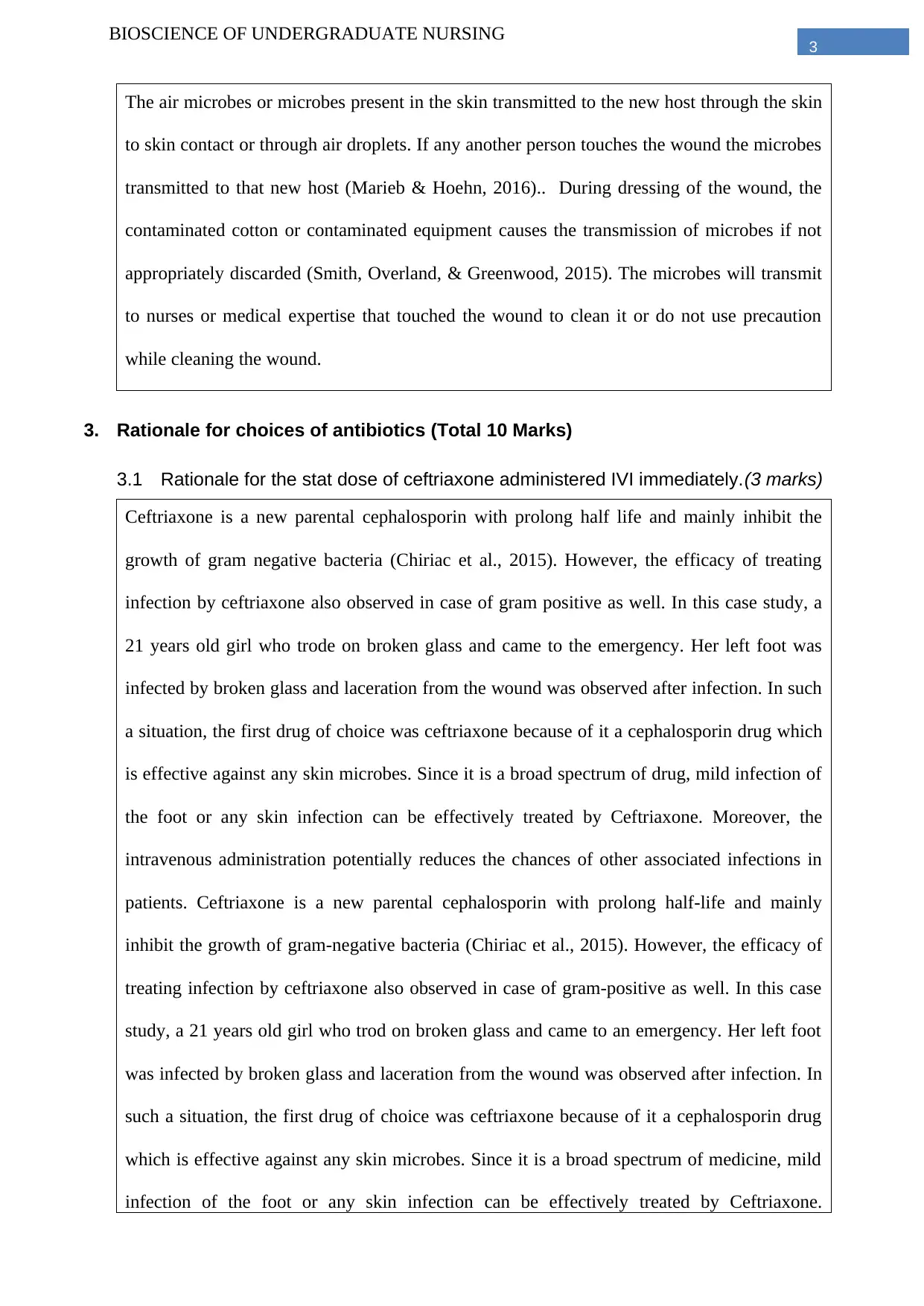
3
BIOSCIENCE OF UNDERGRADUATE NURSING
The air microbes or microbes present in the skin transmitted to the new host through the skin
to skin contact or through air droplets. If any another person touches the wound the microbes
transmitted to that new host (Marieb & Hoehn, 2016).. During dressing of the wound, the
contaminated cotton or contaminated equipment causes the transmission of microbes if not
appropriately discarded (Smith, Overland, & Greenwood, 2015). The microbes will transmit
to nurses or medical expertise that touched the wound to clean it or do not use precaution
while cleaning the wound.
3. Rationale for choices of antibiotics (Total 10 Marks)
3.1 Rationale for the stat dose of ceftriaxone administered IVI immediately.(3 marks)
Ceftriaxone is a new parental cephalosporin with prolong half life and mainly inhibit the
growth of gram negative bacteria (Chiriac et al., 2015). However, the efficacy of treating
infection by ceftriaxone also observed in case of gram positive as well. In this case study, a
21 years old girl who trode on broken glass and came to the emergency. Her left foot was
infected by broken glass and laceration from the wound was observed after infection. In such
a situation, the first drug of choice was ceftriaxone because of it a cephalosporin drug which
is effective against any skin microbes. Since it is a broad spectrum of drug, mild infection of
the foot or any skin infection can be effectively treated by Ceftriaxone. Moreover, the
intravenous administration potentially reduces the chances of other associated infections in
patients. Ceftriaxone is a new parental cephalosporin with prolong half-life and mainly
inhibit the growth of gram-negative bacteria (Chiriac et al., 2015). However, the efficacy of
treating infection by ceftriaxone also observed in case of gram-positive as well. In this case
study, a 21 years old girl who trod on broken glass and came to an emergency. Her left foot
was infected by broken glass and laceration from the wound was observed after infection. In
such a situation, the first drug of choice was ceftriaxone because of it a cephalosporin drug
which is effective against any skin microbes. Since it is a broad spectrum of medicine, mild
infection of the foot or any skin infection can be effectively treated by Ceftriaxone.
BIOSCIENCE OF UNDERGRADUATE NURSING
The air microbes or microbes present in the skin transmitted to the new host through the skin
to skin contact or through air droplets. If any another person touches the wound the microbes
transmitted to that new host (Marieb & Hoehn, 2016).. During dressing of the wound, the
contaminated cotton or contaminated equipment causes the transmission of microbes if not
appropriately discarded (Smith, Overland, & Greenwood, 2015). The microbes will transmit
to nurses or medical expertise that touched the wound to clean it or do not use precaution
while cleaning the wound.
3. Rationale for choices of antibiotics (Total 10 Marks)
3.1 Rationale for the stat dose of ceftriaxone administered IVI immediately.(3 marks)
Ceftriaxone is a new parental cephalosporin with prolong half life and mainly inhibit the
growth of gram negative bacteria (Chiriac et al., 2015). However, the efficacy of treating
infection by ceftriaxone also observed in case of gram positive as well. In this case study, a
21 years old girl who trode on broken glass and came to the emergency. Her left foot was
infected by broken glass and laceration from the wound was observed after infection. In such
a situation, the first drug of choice was ceftriaxone because of it a cephalosporin drug which
is effective against any skin microbes. Since it is a broad spectrum of drug, mild infection of
the foot or any skin infection can be effectively treated by Ceftriaxone. Moreover, the
intravenous administration potentially reduces the chances of other associated infections in
patients. Ceftriaxone is a new parental cephalosporin with prolong half-life and mainly
inhibit the growth of gram-negative bacteria (Chiriac et al., 2015). However, the efficacy of
treating infection by ceftriaxone also observed in case of gram-positive as well. In this case
study, a 21 years old girl who trod on broken glass and came to an emergency. Her left foot
was infected by broken glass and laceration from the wound was observed after infection. In
such a situation, the first drug of choice was ceftriaxone because of it a cephalosporin drug
which is effective against any skin microbes. Since it is a broad spectrum of medicine, mild
infection of the foot or any skin infection can be effectively treated by Ceftriaxone.
Paraphrase This Document
Need a fresh take? Get an instant paraphrase of this document with our AI Paraphraser
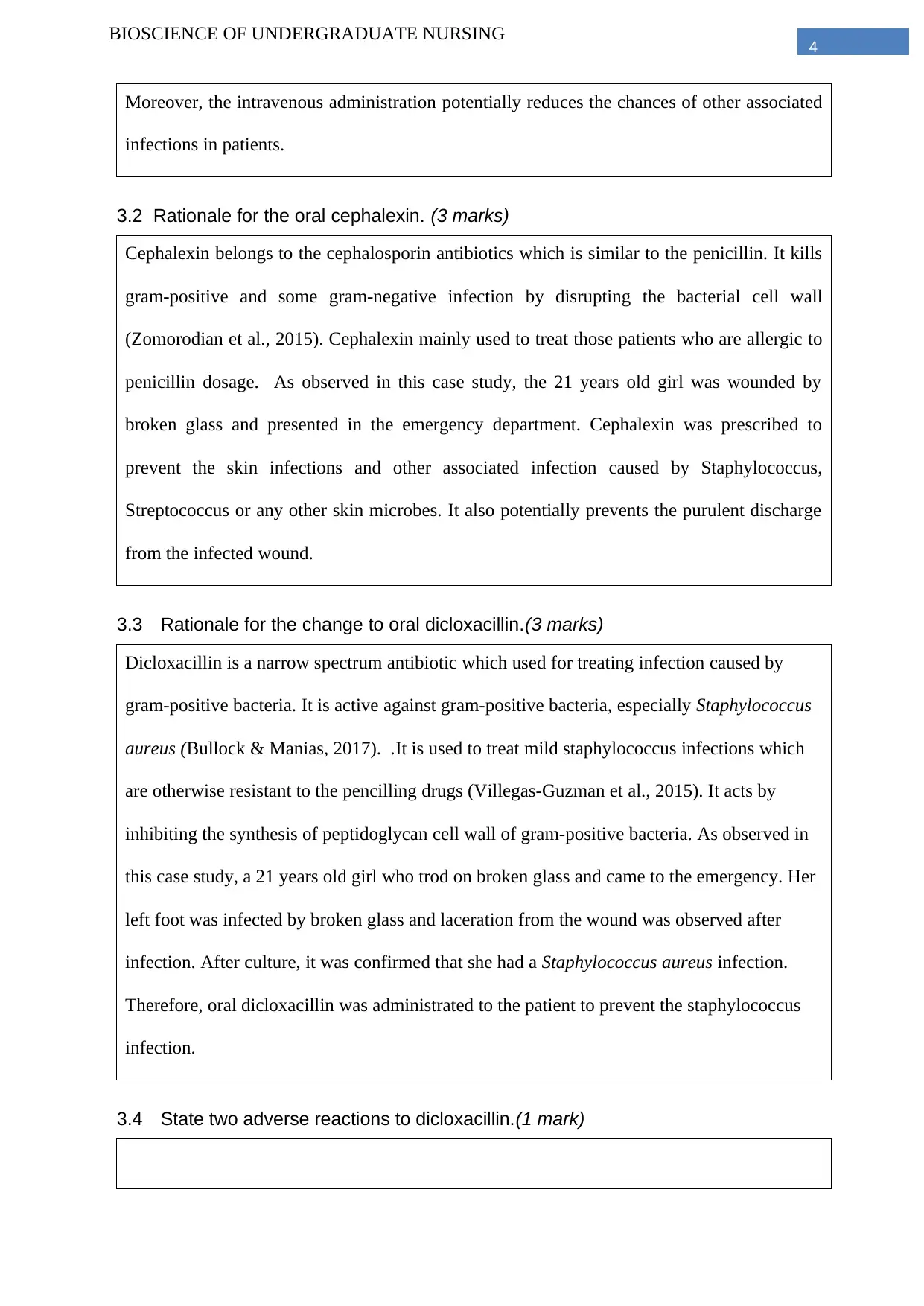
4
BIOSCIENCE OF UNDERGRADUATE NURSING
Moreover, the intravenous administration potentially reduces the chances of other associated
infections in patients.
3.2 Rationale for the oral cephalexin. (3 marks)
Cephalexin belongs to the cephalosporin antibiotics which is similar to the penicillin. It kills
gram-positive and some gram-negative infection by disrupting the bacterial cell wall
(Zomorodian et al., 2015). Cephalexin mainly used to treat those patients who are allergic to
penicillin dosage. As observed in this case study, the 21 years old girl was wounded by
broken glass and presented in the emergency department. Cephalexin was prescribed to
prevent the skin infections and other associated infection caused by Staphylococcus,
Streptococcus or any other skin microbes. It also potentially prevents the purulent discharge
from the infected wound.
3.3 Rationale for the change to oral dicloxacillin.(3 marks)
Dicloxacillin is a narrow spectrum antibiotic which used for treating infection caused by
gram-positive bacteria. It is active against gram-positive bacteria, especially Staphylococcus
aureus (Bullock & Manias, 2017). .It is used to treat mild staphylococcus infections which
are otherwise resistant to the pencilling drugs (Villegas-Guzman et al., 2015). It acts by
inhibiting the synthesis of peptidoglycan cell wall of gram-positive bacteria. As observed in
this case study, a 21 years old girl who trod on broken glass and came to the emergency. Her
left foot was infected by broken glass and laceration from the wound was observed after
infection. After culture, it was confirmed that she had a Staphylococcus aureus infection.
Therefore, oral dicloxacillin was administrated to the patient to prevent the staphylococcus
infection.
3.4 State two adverse reactions to dicloxacillin.(1 mark)
BIOSCIENCE OF UNDERGRADUATE NURSING
Moreover, the intravenous administration potentially reduces the chances of other associated
infections in patients.
3.2 Rationale for the oral cephalexin. (3 marks)
Cephalexin belongs to the cephalosporin antibiotics which is similar to the penicillin. It kills
gram-positive and some gram-negative infection by disrupting the bacterial cell wall
(Zomorodian et al., 2015). Cephalexin mainly used to treat those patients who are allergic to
penicillin dosage. As observed in this case study, the 21 years old girl was wounded by
broken glass and presented in the emergency department. Cephalexin was prescribed to
prevent the skin infections and other associated infection caused by Staphylococcus,
Streptococcus or any other skin microbes. It also potentially prevents the purulent discharge
from the infected wound.
3.3 Rationale for the change to oral dicloxacillin.(3 marks)
Dicloxacillin is a narrow spectrum antibiotic which used for treating infection caused by
gram-positive bacteria. It is active against gram-positive bacteria, especially Staphylococcus
aureus (Bullock & Manias, 2017). .It is used to treat mild staphylococcus infections which
are otherwise resistant to the pencilling drugs (Villegas-Guzman et al., 2015). It acts by
inhibiting the synthesis of peptidoglycan cell wall of gram-positive bacteria. As observed in
this case study, a 21 years old girl who trod on broken glass and came to the emergency. Her
left foot was infected by broken glass and laceration from the wound was observed after
infection. After culture, it was confirmed that she had a Staphylococcus aureus infection.
Therefore, oral dicloxacillin was administrated to the patient to prevent the staphylococcus
infection.
3.4 State two adverse reactions to dicloxacillin.(1 mark)
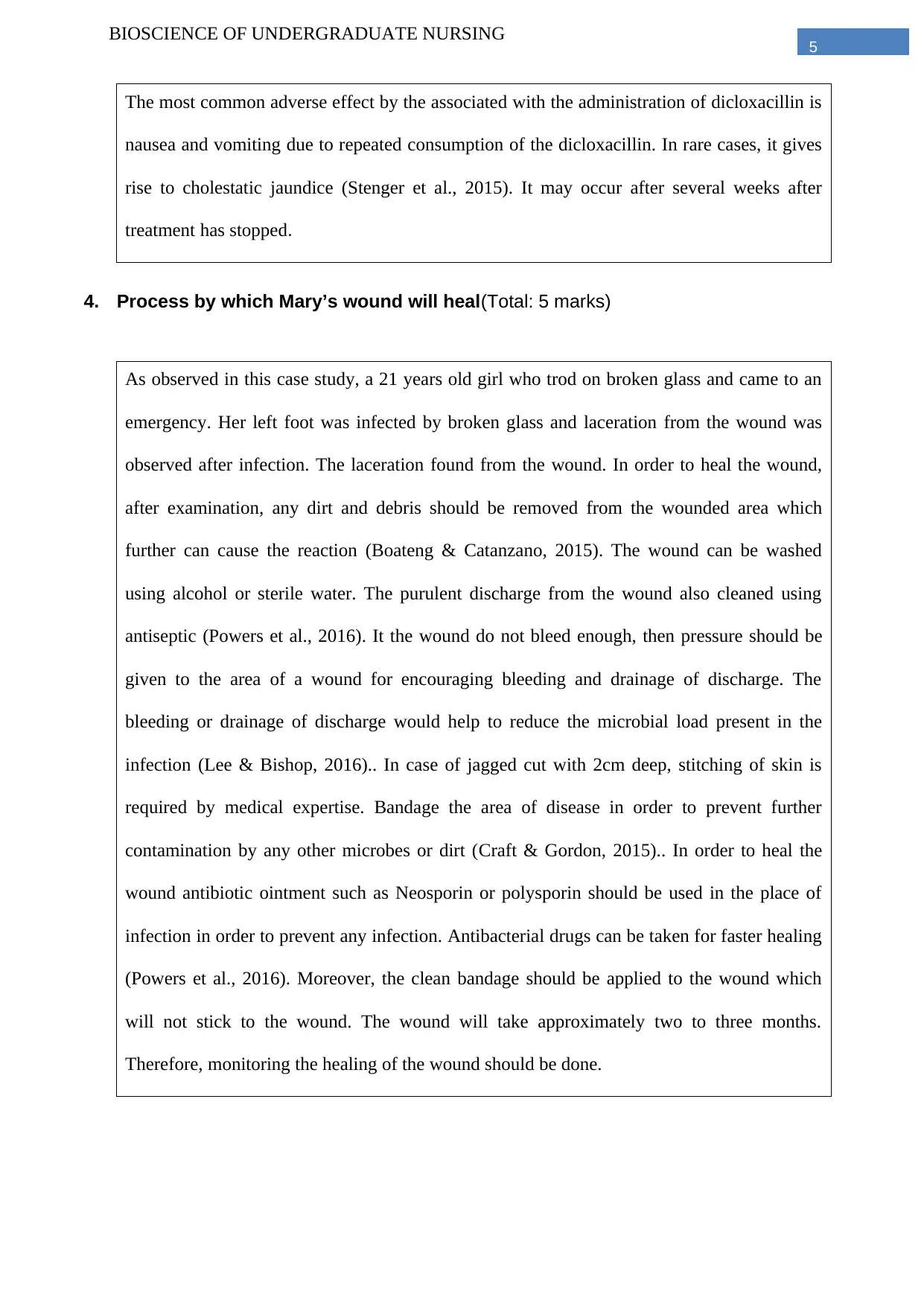
5
BIOSCIENCE OF UNDERGRADUATE NURSING
The most common adverse effect by the associated with the administration of dicloxacillin is
nausea and vomiting due to repeated consumption of the dicloxacillin. In rare cases, it gives
rise to cholestatic jaundice (Stenger et al., 2015). It may occur after several weeks after
treatment has stopped.
4. Process by which Mary’s wound will heal(Total: 5 marks)
As observed in this case study, a 21 years old girl who trod on broken glass and came to an
emergency. Her left foot was infected by broken glass and laceration from the wound was
observed after infection. The laceration found from the wound. In order to heal the wound,
after examination, any dirt and debris should be removed from the wounded area which
further can cause the reaction (Boateng & Catanzano, 2015). The wound can be washed
using alcohol or sterile water. The purulent discharge from the wound also cleaned using
antiseptic (Powers et al., 2016). It the wound do not bleed enough, then pressure should be
given to the area of a wound for encouraging bleeding and drainage of discharge. The
bleeding or drainage of discharge would help to reduce the microbial load present in the
infection (Lee & Bishop, 2016).. In case of jagged cut with 2cm deep, stitching of skin is
required by medical expertise. Bandage the area of disease in order to prevent further
contamination by any other microbes or dirt (Craft & Gordon, 2015).. In order to heal the
wound antibiotic ointment such as Neosporin or polysporin should be used in the place of
infection in order to prevent any infection. Antibacterial drugs can be taken for faster healing
(Powers et al., 2016). Moreover, the clean bandage should be applied to the wound which
will not stick to the wound. The wound will take approximately two to three months.
Therefore, monitoring the healing of the wound should be done.
BIOSCIENCE OF UNDERGRADUATE NURSING
The most common adverse effect by the associated with the administration of dicloxacillin is
nausea and vomiting due to repeated consumption of the dicloxacillin. In rare cases, it gives
rise to cholestatic jaundice (Stenger et al., 2015). It may occur after several weeks after
treatment has stopped.
4. Process by which Mary’s wound will heal(Total: 5 marks)
As observed in this case study, a 21 years old girl who trod on broken glass and came to an
emergency. Her left foot was infected by broken glass and laceration from the wound was
observed after infection. The laceration found from the wound. In order to heal the wound,
after examination, any dirt and debris should be removed from the wounded area which
further can cause the reaction (Boateng & Catanzano, 2015). The wound can be washed
using alcohol or sterile water. The purulent discharge from the wound also cleaned using
antiseptic (Powers et al., 2016). It the wound do not bleed enough, then pressure should be
given to the area of a wound for encouraging bleeding and drainage of discharge. The
bleeding or drainage of discharge would help to reduce the microbial load present in the
infection (Lee & Bishop, 2016).. In case of jagged cut with 2cm deep, stitching of skin is
required by medical expertise. Bandage the area of disease in order to prevent further
contamination by any other microbes or dirt (Craft & Gordon, 2015).. In order to heal the
wound antibiotic ointment such as Neosporin or polysporin should be used in the place of
infection in order to prevent any infection. Antibacterial drugs can be taken for faster healing
(Powers et al., 2016). Moreover, the clean bandage should be applied to the wound which
will not stick to the wound. The wound will take approximately two to three months.
Therefore, monitoring the healing of the wound should be done.
⊘ This is a preview!⊘
Do you want full access?
Subscribe today to unlock all pages.

Trusted by 1+ million students worldwide
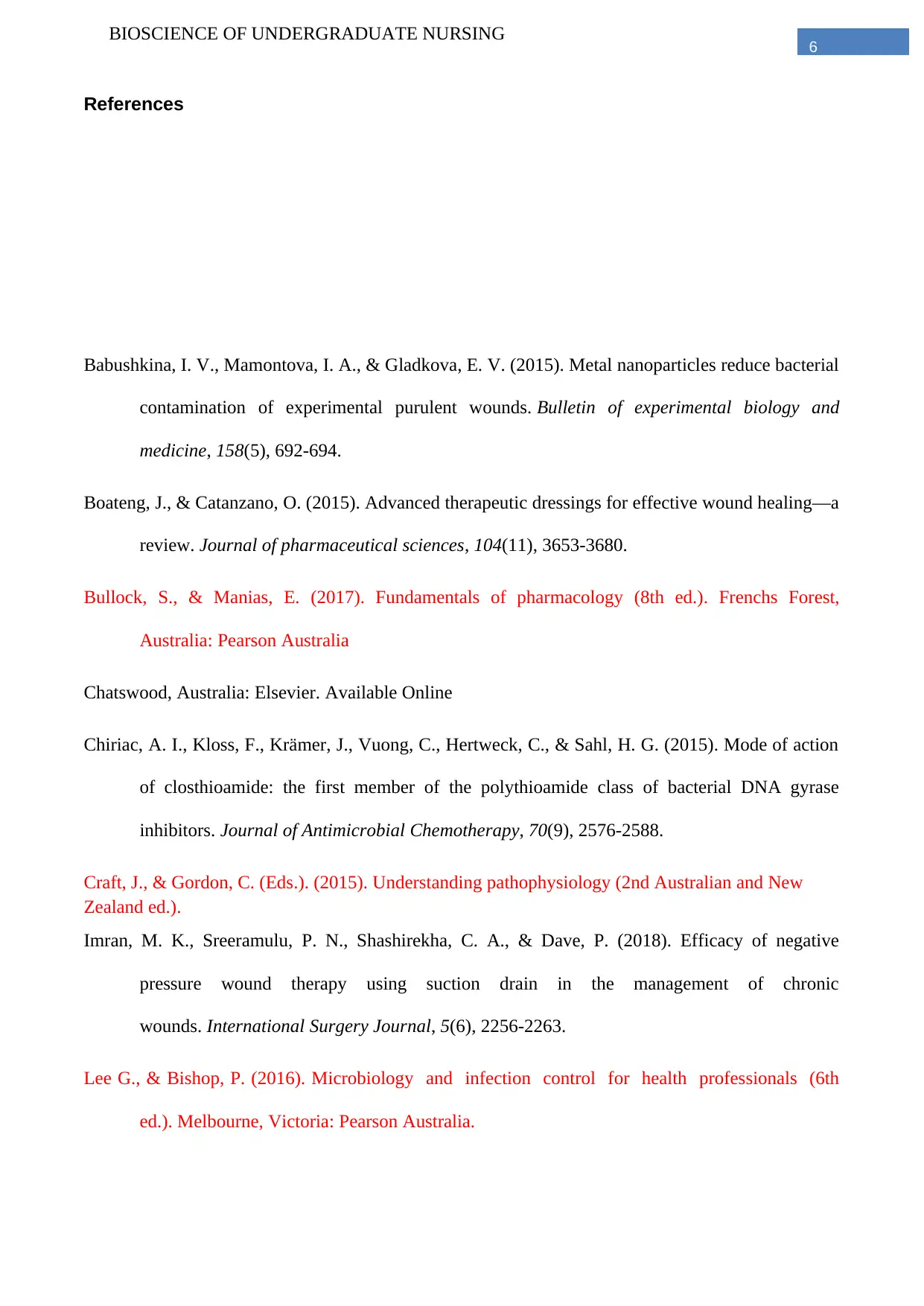
6
BIOSCIENCE OF UNDERGRADUATE NURSING
References
Babushkina, I. V., Mamontova, I. A., & Gladkova, E. V. (2015). Metal nanoparticles reduce bacterial
contamination of experimental purulent wounds. Bulletin of experimental biology and
medicine, 158(5), 692-694.
Boateng, J., & Catanzano, O. (2015). Advanced therapeutic dressings for effective wound healing—a
review. Journal of pharmaceutical sciences, 104(11), 3653-3680.
Bullock, S., & Manias, E. (2017). Fundamentals of pharmacology (8th ed.). Frenchs Forest,
Australia: Pearson Australia
Chatswood, Australia: Elsevier. Available Online
Chiriac, A. I., Kloss, F., Krämer, J., Vuong, C., Hertweck, C., & Sahl, H. G. (2015). Mode of action
of closthioamide: the first member of the polythioamide class of bacterial DNA gyrase
inhibitors. Journal of Antimicrobial Chemotherapy, 70(9), 2576-2588.
Craft, J., & Gordon, C. (Eds.). (2015). Understanding pathophysiology (2nd Australian and New
Zealand ed.).
Imran, M. K., Sreeramulu, P. N., Shashirekha, C. A., & Dave, P. (2018). Efficacy of negative
pressure wound therapy using suction drain in the management of chronic
wounds. International Surgery Journal, 5(6), 2256-2263.
Lee G., & Bishop, P. (2016). Microbiology and infection control for health professionals (6th
ed.). Melbourne, Victoria: Pearson Australia.
BIOSCIENCE OF UNDERGRADUATE NURSING
References
Babushkina, I. V., Mamontova, I. A., & Gladkova, E. V. (2015). Metal nanoparticles reduce bacterial
contamination of experimental purulent wounds. Bulletin of experimental biology and
medicine, 158(5), 692-694.
Boateng, J., & Catanzano, O. (2015). Advanced therapeutic dressings for effective wound healing—a
review. Journal of pharmaceutical sciences, 104(11), 3653-3680.
Bullock, S., & Manias, E. (2017). Fundamentals of pharmacology (8th ed.). Frenchs Forest,
Australia: Pearson Australia
Chatswood, Australia: Elsevier. Available Online
Chiriac, A. I., Kloss, F., Krämer, J., Vuong, C., Hertweck, C., & Sahl, H. G. (2015). Mode of action
of closthioamide: the first member of the polythioamide class of bacterial DNA gyrase
inhibitors. Journal of Antimicrobial Chemotherapy, 70(9), 2576-2588.
Craft, J., & Gordon, C. (Eds.). (2015). Understanding pathophysiology (2nd Australian and New
Zealand ed.).
Imran, M. K., Sreeramulu, P. N., Shashirekha, C. A., & Dave, P. (2018). Efficacy of negative
pressure wound therapy using suction drain in the management of chronic
wounds. International Surgery Journal, 5(6), 2256-2263.
Lee G., & Bishop, P. (2016). Microbiology and infection control for health professionals (6th
ed.). Melbourne, Victoria: Pearson Australia.
Paraphrase This Document
Need a fresh take? Get an instant paraphrase of this document with our AI Paraphraser
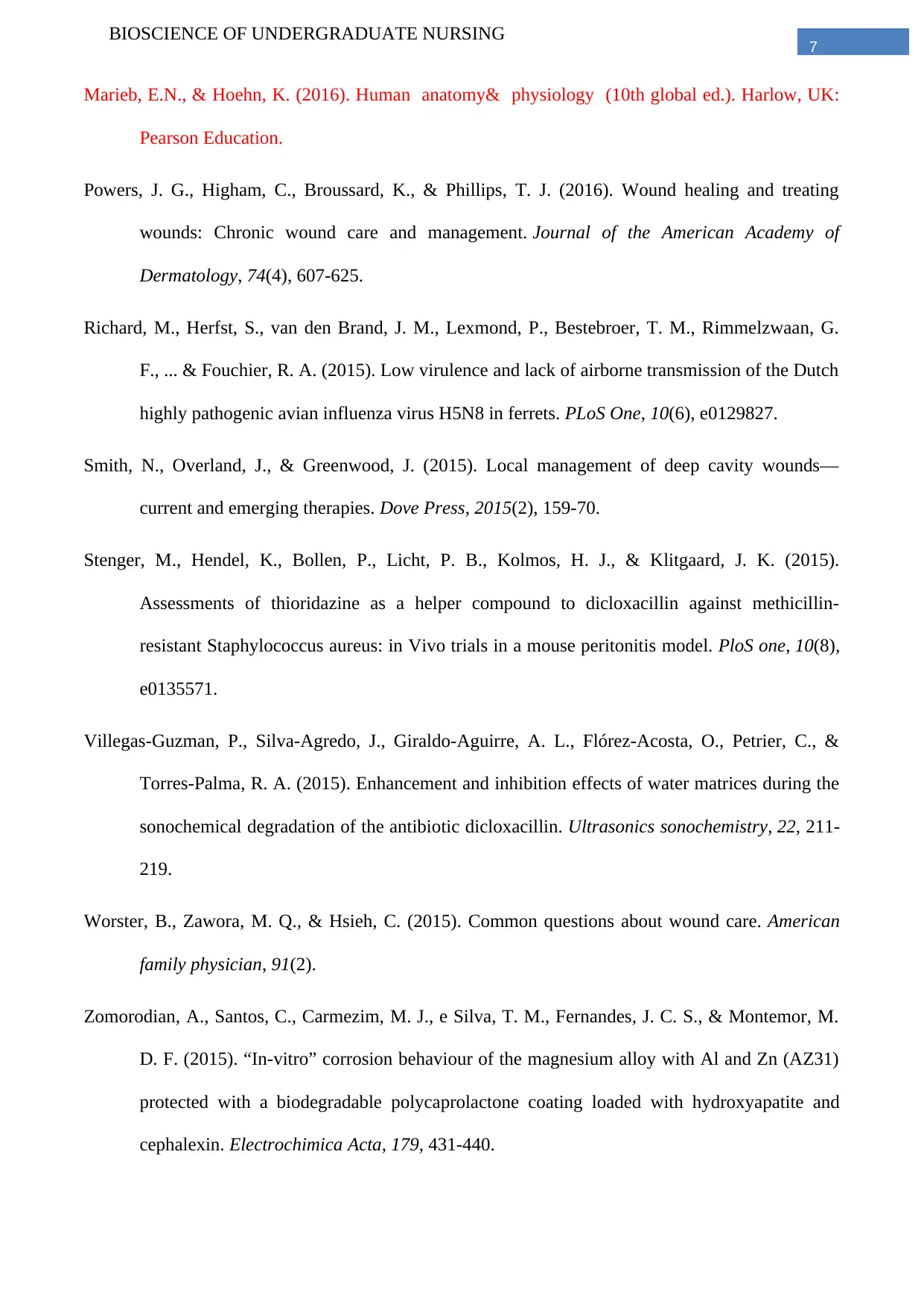
7
BIOSCIENCE OF UNDERGRADUATE NURSING
Marieb, E.N., & Hoehn, K. (2016). Human anatomy& physiology (10th global ed.). Harlow, UK:
Pearson Education.
Powers, J. G., Higham, C., Broussard, K., & Phillips, T. J. (2016). Wound healing and treating
wounds: Chronic wound care and management. Journal of the American Academy of
Dermatology, 74(4), 607-625.
Richard, M., Herfst, S., van den Brand, J. M., Lexmond, P., Bestebroer, T. M., Rimmelzwaan, G.
F., ... & Fouchier, R. A. (2015). Low virulence and lack of airborne transmission of the Dutch
highly pathogenic avian influenza virus H5N8 in ferrets. PLoS One, 10(6), e0129827.
Smith, N., Overland, J., & Greenwood, J. (2015). Local management of deep cavity wounds—
current and emerging therapies. Dove Press, 2015(2), 159-70.
Stenger, M., Hendel, K., Bollen, P., Licht, P. B., Kolmos, H. J., & Klitgaard, J. K. (2015).
Assessments of thioridazine as a helper compound to dicloxacillin against methicillin-
resistant Staphylococcus aureus: in Vivo trials in a mouse peritonitis model. PloS one, 10(8),
e0135571.
Villegas-Guzman, P., Silva-Agredo, J., Giraldo-Aguirre, A. L., Flórez-Acosta, O., Petrier, C., &
Torres-Palma, R. A. (2015). Enhancement and inhibition effects of water matrices during the
sonochemical degradation of the antibiotic dicloxacillin. Ultrasonics sonochemistry, 22, 211-
219.
Worster, B., Zawora, M. Q., & Hsieh, C. (2015). Common questions about wound care. American
family physician, 91(2).
Zomorodian, A., Santos, C., Carmezim, M. J., e Silva, T. M., Fernandes, J. C. S., & Montemor, M.
D. F. (2015). “In-vitro” corrosion behaviour of the magnesium alloy with Al and Zn (AZ31)
protected with a biodegradable polycaprolactone coating loaded with hydroxyapatite and
cephalexin. Electrochimica Acta, 179, 431-440.
BIOSCIENCE OF UNDERGRADUATE NURSING
Marieb, E.N., & Hoehn, K. (2016). Human anatomy& physiology (10th global ed.). Harlow, UK:
Pearson Education.
Powers, J. G., Higham, C., Broussard, K., & Phillips, T. J. (2016). Wound healing and treating
wounds: Chronic wound care and management. Journal of the American Academy of
Dermatology, 74(4), 607-625.
Richard, M., Herfst, S., van den Brand, J. M., Lexmond, P., Bestebroer, T. M., Rimmelzwaan, G.
F., ... & Fouchier, R. A. (2015). Low virulence and lack of airborne transmission of the Dutch
highly pathogenic avian influenza virus H5N8 in ferrets. PLoS One, 10(6), e0129827.
Smith, N., Overland, J., & Greenwood, J. (2015). Local management of deep cavity wounds—
current and emerging therapies. Dove Press, 2015(2), 159-70.
Stenger, M., Hendel, K., Bollen, P., Licht, P. B., Kolmos, H. J., & Klitgaard, J. K. (2015).
Assessments of thioridazine as a helper compound to dicloxacillin against methicillin-
resistant Staphylococcus aureus: in Vivo trials in a mouse peritonitis model. PloS one, 10(8),
e0135571.
Villegas-Guzman, P., Silva-Agredo, J., Giraldo-Aguirre, A. L., Flórez-Acosta, O., Petrier, C., &
Torres-Palma, R. A. (2015). Enhancement and inhibition effects of water matrices during the
sonochemical degradation of the antibiotic dicloxacillin. Ultrasonics sonochemistry, 22, 211-
219.
Worster, B., Zawora, M. Q., & Hsieh, C. (2015). Common questions about wound care. American
family physician, 91(2).
Zomorodian, A., Santos, C., Carmezim, M. J., e Silva, T. M., Fernandes, J. C. S., & Montemor, M.
D. F. (2015). “In-vitro” corrosion behaviour of the magnesium alloy with Al and Zn (AZ31)
protected with a biodegradable polycaprolactone coating loaded with hydroxyapatite and
cephalexin. Electrochimica Acta, 179, 431-440.
1 out of 8
Related Documents
Your All-in-One AI-Powered Toolkit for Academic Success.
+13062052269
info@desklib.com
Available 24*7 on WhatsApp / Email
![[object Object]](/_next/static/media/star-bottom.7253800d.svg)
Unlock your academic potential
Copyright © 2020–2025 A2Z Services. All Rights Reserved. Developed and managed by ZUCOL.


